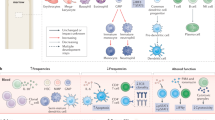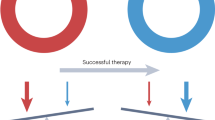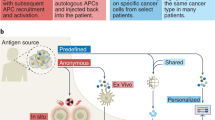Abstract
The concept that the immune system can recognize and destroy nascent transformed cells was originally embodied in the cancer immunosurveillance hypothesis of Burnet and Thomas. This hypothesis was abandoned shortly afterwards because of the absence of strong experimental evidence supporting the concept. New data, however, clearly show the existence of cancer immunosurveillance and also indicate that it may function as a component of a more general process of cancer immunoediting. This process is responsible for both eliminating tumors and sculpting the immunogenic phenotypes of tumors that eventually form in immunocompetent hosts. In this review, we will summarize the historical and experimental basis of cancer immunoediting and discuss its dual roles in promoting host protection against cancer and facilitating tumor escape from immune destruction.
This is a preview of subscription content, access via your institution
Access options
Subscribe to this journal
Receive 12 print issues and online access
$209.00 per year
only $17.42 per issue
Buy this article
- Purchase on Springer Link
- Instant access to full article PDF
Prices may be subject to local taxes which are calculated during checkout


Similar content being viewed by others
References
Ehrlich, P. Ueber den jetzigen stand der Karzinomforschung. Ned. Tijdschr. Geneeskd. 5, 273–290 (1909).
Silverstein, A.M. A History of Immunology (Academic, San Diego, CA, 1989).
Old, L.J. & Boyse, E.A. Immunology of experimental tumors. Annu. Rev. Med. 15, 167–186 (1964).
Klein, G. Tumor antigens. Annu. Rev. Microbiol. 20, 223–252 (1966).
Burnet, F.M. Cancer—a biological approach. Brit. Med. J. 1, 841–847 (1957).
Thomas, L. in Cellular and Humoral Aspects of the Hypersensitive States (ed. Lawrence, H. S.) 529–532 (Hoeber-Harper, New York, 1959).
Burnet, F.M. The concept of immunological surveillance. Prog. Exp. Tumor Res. 13, 1–27 (1970).
Burnet, F.M. Immunological factors in the process of carcinogenesis. Br. Med. Bull. 20, 154–158 (1964).
Kaplan, H.S. Role of immunologic disturbance in human oncogenesis: some facts and fancies. Br. J. Cancer 25, 620–634 (1971).
Stutman, O. Immunodepression and malignancy. Adv. Cancer Res. 22, 261–422 (1975).
Grant, G.A. & Miller, J.F. Effect of neonatal thymectomy on the induction of sarcomata in C57BL mice. Nature 205, 1124–1125 (1965).
Nishizuka, Y., Nakakuki, K. & Usui, M. Enhancing effect of thymectomy on hepatotumorigenesis in Swiss mice following neonatal injection of 20-methylcholanthrene. Nature 205, 1236–1238 (1965).
Trainin, N., Linker-Israeli, M., Small, M. & Boiato-Chen, L. Enhancement of lung adenoma formation by neonatal thymectomy in mice treated with 7,12-dimethylbenz(a)anthracene or urethan. Int. J. Cancer 2, 326–336 (1967).
Burstein, N.A. & Law, L.W. Neonatal thymectomy and non-viral mammary tumours in mice. Nature 231, 450–452 (1971).
Sanford, B.H., Kohn, H.I., Daly, J.J. & Soo, S.F. Long-term spontaneous tumor incidence in neonatally thymectomized mice. J. Immunol. 110, 1437–1439 (1973).
Klein, G. Immunological surveillance against neoplasia. Harvey Lect., 71–102 (1973).
Flanagan, S.P. 'Nude', a new hairless gene with pleiotropic effects in the mouse. Genet. Res. 8, 295–309 (1966).
Pantelouris, E.M. Absence of thymus in a mouse mutant. Nature 217, 370–371 (1968).
Stutman, O. Tumor development after 3-methylcholanthrene in immunologically deficient athymic-nude mice. Science 183, 534–536 (1974).
Stutman, O. in Proceedings of the International Workshop on Nude Mice Vol. 1 (eds. Rygaard, J. & Poulsen, C.) 257–264 (Gustav Fischer, Stuttgart 1973).
Stutman, O. Chemical carcinogenesis in nude mice: comparison between nude mice from homozygous and heterozygous matings and effect of age and carcinogen dose. J. Natl. Cancer Inst. 2, 353–358 (1979).
Outzen, H.C., Custer, R.P., Eaton, G.J. & Prehn, R.T. Spontaneous and induced tumor incidence in germfree “nude” mice. J. Reticuloendothel. Soc. 17, 1–9 (1975).
Stutman, O. in The Nude Mouse in Experimental and Clinical Research (eds. Fogh, J. & Giovanella, B. C.) 411–435 (Academic, New York, 1978).
Rygaard, J. & Povlsen, C.O. Is immunological surveillance not a cell-mediated immune function? Transplantation 17, 135–136 (1974).
Rygaard, J. & Povlsen, C.O. The mouse mutant nude does not develop spontaneous tumours. An argument against immunological surveillance. Acta Pathol. Microbiol. Scand. [B] Microbiol. Immunol. 82, 99–106 (1974).
Maleckar, J.R. & Sherman, L.A. The composition of the T cell receptor repertoire in nude mice. J. Immunol. 138, 3873–3876 (1987).
Ikehara, S., Pahwa, R.N., Fernandes, G., Hansen, C.T. & Good, R.A. Functional T cells in athymic nude mice. Proc. Natl. Acad. Sci. USA 81, 886–888 (1984).
Hunig, T. T-cell function and specificity in athymic mice. Immunol. Today 4, 84–87 (1983).
Heidelberger, C. Chemical carcinogenesis. Annu. Rev. Biochem. 44, 79–121 (1975).
Kouri, R.E. & Nebert, D.W. in Origins of Human Cancer (eds. Hiatt, H. H., Watson, J. D. & Winsten, J. A.) 811–835 (Cold Spring Harbor Laboratory Press, Cold Spring Harbor, NY, 1977).
Hayday, A.C. γδ cells: a right time and a right place for a conserved third way of protection. Annu. Rev. Immunol. 18, 975–1026 (2000).
Prehn, R.T. Perspectives on oncogenesis: does immunity stimulate or inhibit neoplasia? J. Reticuloenothel. Soc. 10, 1–16 (1970).
Thomas, L. On immunosurveillance in human cancer. Yale J. Biol. Med. 55, 329–333 (1982).
Hanahan, D. & Weinberg, R.A. The hallmarks of cancer. Cell 100, 57–70 (2000).
Herberman, R.B. & Holden, H.T. Natural cell-mediated immunity. Adv. Cancer Res. 27, 305–377 (1978).
Engel, A.M. et al. Methylcholanthrene-induced sarcomas in nude mice have short induction times and relatively low levels of surface MHC class I expression. APMIS 104, 629–639 (1996).
Engel, A.M., Svane, I.M., Rygaard, J. & Werdelin, O. MCA sarcomas induced in scid mice are more immunogenic than MCA sarcomas induced in congenic, immunocompetent mice. Scand. J. Immunol. 45, 463–470 (1997).
Schuler, W. et al. Rearrangement of antigen receptor genes is defective in mice with severe combined immune deficiency. Cell 46, 963–972 (1986).
Featherstone, C. & Jackson, S.P. DNA double-strand break repair. Curr. Biol. 9, R759–R761 (1999).
Dighe, A.S., Richards, E., Old, L.J. & Schreiber, R.D. Enhanced in vivo growth and resistance to rejection of tumor cells expressing dominant negative IFN-γ receptors. Immunity 1, 447–456 (1994).
Kaplan, D.H. et al. Demonstration of an interferon γ-dependent tumor surveillance system in immunocompetent mice. Proc. Natl. Acad. Sci. USA 95, 7556–7561 (1998).
Street, S.E., Cretney, E. & Smyth, M.J. Perforin and interferon-γ activities independently control tumor initiation, growth, and metastasis. Blood 97, 192–197 (2001).
Street, S.E., Trapani, J.A., MacGregor, D. & Smyth, M.J. Suppression of lymphoma and epithelial malignancies effected by interferon γ. J. Exp. Med. 196, 129–134 (2002).
Russell, J.H. & Ley, T.J. Lymphocyte-mediated cytotoxicity. Annu. Rev. Immunol. 20, 323–370 (2002).
van den Broek, M.F. et al. Decreased tumor surveillance in perforin-deficient mice. J.Exp.Med. 184, 1781–1790 (1996).
Smyth, M.J. et al. Differential tumor surveillance by natural killer (NK) and NKT cells. J. Exp. Med. 191, 661–668 (2000).
Smyth, M.J. et al. Perforin-mediated cytotoxicity is critical for surveillance of spontaneous lymphoma. J. Exp. Med. 192, 755–760 (2000).
Shinkai, Y. et al. RAG-2-deficient mice lack mature lymphocytes owing to inability to initiate V(D)J rearrangement. Cell 68, 855–867 (1992).
Shankaran, V. et al. IFN-γ and lymphocytes prevent primary tumour development and shape tumour immunogenicity. Nature 410, 1107–1111 (2001).
Girardi, M. et al. Regulation of cutaneous malignancy by γδ T cells. Science 294, 605–609 (2001).
Penn, I. Malignant Tumors in Organ Transplant Recipients (Springer-Verlag, New York, 1970).
Gatti, R.A. & Good, R.A. Occurrence of malignancy in immunodeficiency diseases. A literature review. Cancer 28, 89–98 (1971).
Penn, I. Posttransplant malignancies. Transplant Proc. 31, 1260–1262 (1999).
Birkeland, S.A. et al. Cancer risk after renal transplantation in the Nordic countries, 1964-1986. Int. J. Cancer 60, 183–189 (1995).
Sheil, A.G.R. in Kidney Transplantation (ed. Morris, P. J.) 558–570 (Saunders, Philadelphia, 2001).
Boshoff, C. & Weiss, R. AIDS-related malignancies. Nature Rev. Cancer 2, 373–382 (2002).
Hoover, R.N. in Origins of Human Cancer (eds. Hiatt, H. H., Watson, J. D. & Winsten, J. A.) 369–379 (Cold Spring Harbor Laboratory Press, Cold Spring Harbor, NY, 1977).
Sheil, A.G. Cancer after transplantation. World J. Surg. 10, 389–396 (1986).
Penn, I. Malignant melanoma in organ allograft recipients. Transplantation 61, 274–278 (1996).
Penn, I. Sarcomas in organ allograft recipients. Transplantation 60, 1485–1491 (1995).
Pham, S.M. et al. Solid tumors after heart transplantation: lethality of lung cancer. Ann. Thorac. Surg. 60, 1623–1626 (1995).
Clark, W.H. Jr et al. Model predicting survival in stage I melanoma based on tumor progression. J. Natl. Cancer Inst. 81, 1893–1904 (1989).
Clemente, C.G. et al. Prognostic value of tumor infiltrating lymphocytes in the vertical growth phase of primary cutaneous melanoma. Cancer 77, 1303–1310 (1996).
Mihm, M.C. Jr, Clemente, C.G. & Cascinelli, N. Tumor infiltrating lymphocytes in lymph node melanoma metastases: a histopathologic prognostic indicator and an expression of local immune response. Lab. Invest. 74, 43–47 (1996).
Rilke, F. et al. Prognostic significance of HER-2/neu expression in breast cancer and its relationship to other prognostic factors. Int. J. Cancer 49, 44–49 (1991).
Lipponen, P.K., Eskelinen, M.J., Jauhiainen, K., Harju, E. & Terho, R. Tumour infiltrating lymphocytes as an independent prognostic factor in transitional cell bladder cancer. Eur. J. Cancer 29A, 69–75 (1992).
Nacopoulou, L., Azaris, P., Papacharalampous, N. & Davaris, P. Prognostic significance of histologic host response in cancer of the large bowel. Cancer 47, 930–936 (1981).
Naito, Y. et al. CD8+ T cells infiltrated within cancer cell nests as a prognostic factor in human colorectal cancer. Cancer Res. 58, 3491–3494 (1998).
Epstein, N.A. & Fatti, L.P. Prostatic carcinoma: some morphological features affecting prognosis. Cancer 37, 2455–2465 (1976).
Deligdisch, L., Jacobs, A.J. & Cohen, C.J. Histologic correlates of virulence in ovarian adenocarcinoma. II. Morphologic correlates of host response. Am. J. Obstet. Gynecol. 144, 885–889 (1982).
Jass, J.R. Lymphocytic infiltration and survival in rectal cancer. J. Clin. Pathol. 39, 585–589 (1986).
Palma, L., Di Lorenzo, N. & Guidetti, B. Lymphocytic infiltrates in primary glioblastomas and recidivous gliomas. Incidence, fate, and relevance to prognosis in 228 operated cases. J. Neurosurg. 49, 854–861 (1978).
Uyttenhove, C., Van Snick, J. & Boon, T. Immunogenic variants obtained by mutagenesis of mouse mastocytoma P815. I. Rejection by syngeneic mice. J. Exp. Med. 152, 1175–1183 (1980).
Urban, J.L., Holland, J.M., Kripke, M.L. & Schreiber, H. Immunoselection of tumor cell variants by mice suppressed with ultraviolet radiation. J. Exp. Med. 156, 1025–1041 (1982).
Svane, I.M. et al. Chemically induced sarcomas from nude mice are more immunogenic than similar sarcomas from congenic normal mice. Eur. J. Immunol. 26, 1844–1850 (1996).
Lengauer, C., Kinzler, K.W. & Vogelstein, B. Genetic instabilities in human cancers. Nature 396, 643–649 (1998).
Hanahan, D. & Folkman, J. Patterns and emerging mechanisms of the angiogenic switch during tumorigenesis. Cell 86, 353–364 (1996).
Smyth, M.J., Godfrey, D.I. & Trapani, J.A. A fresh look at tumor immunosurveillance and immunotherapy. Nature Immunol. 2, 293–299 (2001).
Matzinger, P. Tolerance, danger, and the extended family. Annu. Rev. Immunol. 12, 991–1045 (1994).
Yokoyama, W.M. Now you see it, now you don't! Nature Immunol. 1, 95–97 (2000).
Cerwenka, A. et al. Retinoic acid early inducible genes define a ligand family for the activating NKG2D receptor in mice. Immunity 12, 721–727 (2000).
Diefenbach, A., Jensen, E.R., Jamieson, A.M. & Raulet, D.H. Rae1 and H60 ligands of the NKG2D receptor stimulate tumour immunity. Nature 413, 165–171 (2001).
Bromberg, J.F., Horvath, C.M., Wen, Z., Schreiber, R.D. & Darnell, J.E. Jr. Transcriptionally active Stat1 is required for the antiproliferative effects of both interferon α and interferon γ. Proc. Natl. Acad. Sci. USA 93, 7673–7678 (1996).
Kumar, A., Commane, M., Flickinger, T.W., Horvath, C.M. & Stark, G.R. Defective TNF-α-induced apoptosis in STAT1-null cells due to low constitutive levels of caspases. Science 278, 1630–1632 (1997).
Luster, A.D. & Ravetch, J.V. Biochemical characterization of a γ interferon-inducible cytokine (IP-10). J. Exp. Med. 166, 1084–1097 (1987).
Liao, F. et al. Human Mig chemokine: biochemical and functional characterization. J. Exp. Med. 182, 1301–1314 (1995).
Cole, K.E. et al. Interferon-inducible T cell α chemoattractant (I-TAC): a novel non-ELR CXC chemokine with potent activity on activated T cells through selective high affinity binding to CXCR3. J. Exp. Med. 187, 2009–2021 (1998).
Luster, A.D. & Leder, P. IP-10, a -C-X-C- chemokine, elicits a potent thymus-dependent antitumor response in vivo. J. Exp. Med. 178, 1057–1065 (1993).
Sgadari, C., Angiolillo, A.L. & Tosato, G. Inhibition of angiogenesis by interleukin-12 is mediated by the interferon-inducible protein 10. Blood 87, 3877–3882 (1996).
Coughlin, C.M. et al. Tumor cell responses to IFN-γ affect tumorigenicity and response to IL-12 therapy and antiangiogenesis. Immunity 9, 25–34 (1998).
Qin, Z. & Blankenstein, T. CD4+ T cell–mediated tumor rejection involves inhibition of angiogenesis that is dependent on IFN-γ receptor expression by nonhematopoietic cells. Immunity 12, 677–686 (2000).
Bancroft, G.J., Schreiber, R.D. & Unanue, E.R. Natural immunity: a T-cell-independent pathway of macrophage activation, defined in the scid mouse. Immunol. Rev. 124, 5–24 (1991).
Trinchieri, G. Interleukin-12: a proinflammatory cytokine with immunoregulatory functions that bridge innate resistance and antigen-specific adaptive immunity. Annu. Rev. Immunol. 13, 251–276 (1995).
Ikeda, H., Old, L.J. & Schreiber, R.D. The roles of IFN-γ in protection against tumor development and cancer immunoediting. Cytokine Growth Factor Rev. 13, 95–109 (2002).
Takeda, K. et al. Critical role for tumor necrosis factor-related apoptosis-inducing ligand in immune surveillance against tumor development. J. Exp. Med. 195, 161–169 (2002).
Pardoll, D.M. Spinning molecular immunology into successful immunotherapy. Nature Rev. Immunol. 2, 227–238 (2002).
Gerosa, F. et al. Reciprocal activating interaction between natural killer cells and dendritic cells. J. Exp. Med. 195, 327–333 (2002).
Ferlazzo, G. et al. Human dendritic cells activate resting natural killer (NK) cells and are recognized via the NKp30 receptor by activated NK cells. J. Exp. Med. 195, 343–351 (2002).
Piccioli, D., Sbrana, S., Melandri, E. & Valiante, N.M. Contact-dependent stimulation and inhibition of dendritic cells by natural killer cells. J. Exp. Med. 195, 335–341 (2002).
Smyth, M.J., Crowe, N.Y. & Godfrey, D.I. NK cells and NKT cells collaborate in host protection from methylcholanthrene-induced fibrosarcoma. Int. Immunol. 13, 459–463 (2001).
Noguchi, Y., Jungbluth, A., Richards, E. & Old, L.J. Effect of interleukin 12 on tumor induction by 3-methylcholanthrene. Proc. Natl. Acad. Sci. USA 93, 11798–11801 (1996).
Acknowledgements
Supported by grants from the National Cancer Institute (CA43059 and CA76464 to R. D. S.), the Cancer Research Institute (to R. D. S., H.I and A.B.), the Ludwig Institute for Cancer Research (to R. D. S.), and the National Institute of Allergy and Infectious Diseases (to R. D. S. and G. P. D.). We thank V. Shankaran, K. Sheehan, A. Dighe, D. Kaplan, R. Uppaluri, C. Koebel, J. Bui, E. Stockert, E. Richards, M. White, C. Arthur and C. Brendel for their important roles in developing the cancer immunoediting concept and for helpful comments during the preparation of this manuscript.
Author information
Authors and Affiliations
Corresponding author
Rights and permissions
About this article
Cite this article
Dunn, G., Bruce, A., Ikeda, H. et al. Cancer immunoediting: from immunosurveillance to tumor escape. Nat Immunol 3, 991–998 (2002). https://doi.org/10.1038/ni1102-991
Issue Date:
DOI: https://doi.org/10.1038/ni1102-991
This article is cited by
-
Myeloid-derived suppressor cells in cancer and cancer therapy
Nature Reviews Clinical Oncology (2024)
-
Immunosurveillance encounters cancer metabolism
EMBO Reports (2024)
-
Epigenetic reprogramming of T cells: unlocking new avenues for cancer immunotherapy
Cancer and Metastasis Reviews (2024)
-
Immunotherapy for Brain Tumors: Where We Have Been, and Where Do We Go From Here?
Current Treatment Options in Oncology (2024)
-
Lentinula Edodes Mycelia extract regulates the function of antigen-presenting cells to activate immune cells and prevent tumor-induced deterioration of immune function
BMC Complementary Medicine and Therapies (2023)



